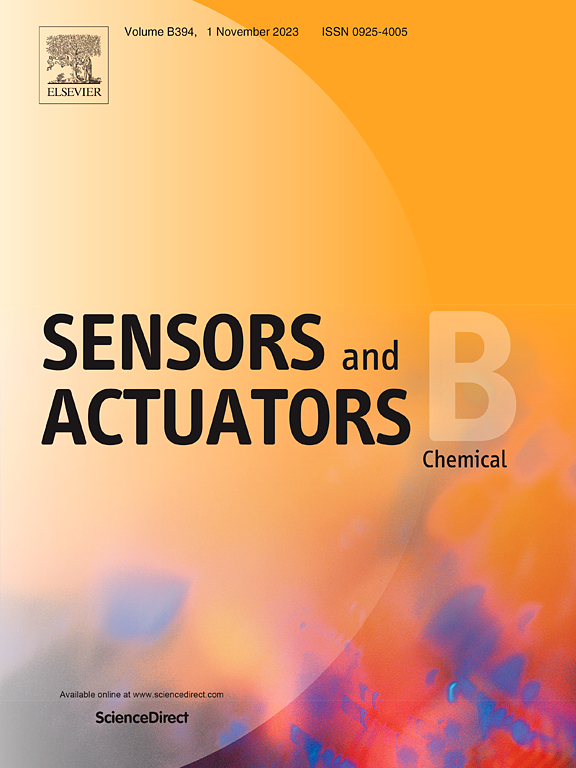A bright lipid drop-targeted probe for dual channel visualizing of colorectal cancer
IF 3.7
1区 化学
Q1 CHEMISTRY, ANALYTICAL
引用次数: 0
Abstract
The absence of reliable early diagnostic tools of colorectal cancer (CRC, one of the malignant digestive tract diseases) and guidance for its surgical resection poses a significant threat to the survival rates of CRC patients. Recent studies have elucidated that CRC frequently exhibits dysfunctional lipid droplets (LDs), and the LDs remain to serve as potential cancer markers due to their considerably lower polarity compared to those in normal cells. Thus, a simple, but advanced, LD-specific fluorescent probe was rationally proposed here. By leveraging both robust aggregation-induced emission (AIE) and twisted intramolecular charge transfer (TICT) effects, the resulting TPA-DCN (triphenylamine-dicyanoethylene) demonstrates extreme sensitivity to the tiny polarity changes and exhibits remarkable fluorescence quantum yields (up to ∼77 %) in the solid state. This probe is also capable of dynamically monitoring the size, quantity and polarity of LDs within cells under various pathological conditions. More exhilaratingly, only using a single excitation wavelength, two-color (green and NIR) long-term tracking (>24 h) of CRC in situ has been realized by leveraging reversible monomer-dimer transitions of TPA-DCN. Moreover, it is manifested by strong anti-interference, resistance to bleaching, high biocompatibility, and precise LD dynamic monitoring under pathological stimuli (oleic acid, simvastatin, LPS). Particularly, the tumor tissue was successfully distinguishable from the normal tissue in vivo, thereby providing a viable method for CRC diagnosis.
一种用于结直肠癌双通道显像的亮脂滴靶向探针
结直肠癌是消化道恶性疾病之一,缺乏可靠的早期诊断工具和手术切除指导,严重威胁结直肠癌患者的生存率。最近的研究表明,结直肠癌经常表现出功能失调的脂滴(LDs),由于与正常细胞相比,LDs的极性明显较低,因此仍然作为潜在的癌症标志物。因此,本文合理地提出了一种简单但先进的ld特异性荧光探针。通过利用强大的聚集诱导发射(AIE)和扭曲分子内电荷转移(TICT)效应,得到的TPA-DCN(三苯胺-二氰乙烯)对微小的极性变化表现出极高的敏感性,并且在固态下表现出显著的荧光量子产率(高达~77%)。该探针还能够在各种病理条件下动态监测细胞内ld的大小、数量和极性。更令人振奋的是,仅使用单一激发波长,利用TPA-DCN的可逆单体-二聚体跃迁,就实现了CRC的双色(绿色和近红外)原位长期跟踪(>24 h)。具有抗干扰性强、耐漂白、生物相容性高、病理刺激(油酸、辛伐他汀、LPS)下LD动态监测精确等特点。特别是在体内成功地将肿瘤组织与正常组织区分开来,从而为CRC的诊断提供了一种可行的方法。
本文章由计算机程序翻译,如有差异,请以英文原文为准。
求助全文
约1分钟内获得全文
求助全文
来源期刊

Sensors and Actuators B: Chemical
工程技术-电化学
CiteScore
14.60
自引率
11.90%
发文量
1776
审稿时长
3.2 months
期刊介绍:
Sensors & Actuators, B: Chemical is an international journal focused on the research and development of chemical transducers. It covers chemical sensors and biosensors, chemical actuators, and analytical microsystems. The journal is interdisciplinary, aiming to publish original works showcasing substantial advancements beyond the current state of the art in these fields, with practical applicability to solving meaningful analytical problems. Review articles are accepted by invitation from an Editor of the journal.
 求助内容:
求助内容: 应助结果提醒方式:
应助结果提醒方式:


